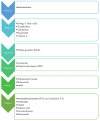Post-COVID-19 Anosmia and Therapies: Stay Tuned for New Drugs to Sniff Out
- PMID: 37366867
- PMCID: PMC10297121
- DOI: 10.3390/diseases11020079
Post-COVID-19 Anosmia and Therapies: Stay Tuned for New Drugs to Sniff Out
Abstract
Background: Anosmia is defined as the complete absence of olfactory function, which can be caused by a variety of causes, with upper respiratory tract infections being among the most frequent causes. Anosmia due to SARS-CoV-2 infection has attracted attention given its main role in symptomatology and the social impact of the pandemic. Methods: We conducted systematic research in a clinicaltrials.gov database to evaluate all active clinical trials worldwide regarding drug therapies in adult patients for anosmia following SARS-CoV-2 infection with the intention of identifying the nearby prospects to treat Anosmia. We use the following search terms: "Anosmia" AND "COVID-19" OR "SARS-CoV-2" OR "2019 novel coronavirus". Results: We found 18 active clinical trials that met our criteria: one phase 1, one phase 1-2, five phases 2, two phases 2-3, three phases 3, and six phases 4 studies were identified. The drug therapies that appear more effective and promising are PEA-LUT and Cerebrolysin. The other interesting drugs are 13-cis-retinoic acid plus aerosolized Vitamin D, dexamethasone, and corticosteroid nasal irrigation. Conclusions: COVID-19 has allowed us to highlight how much anosmia is an important and debilitating symptom for patients and, above all, to direct research to find a therapy aimed at curing the symptom, whether it derives from SARS-CoV-2 infection or other infections of the upper airways. Some of these therapies are very promising and are almost at the end of experimentation. They also provide hope in this field, which not addressed until recently.
Keywords: anosmia; clinical trials; olfactory impairment; post-COVID-19; smell; therapy.
Conflict of interest statement
The authors declare no conflict of interest.
Figures






Similar articles
-
Anosmia: an evolution of our understanding of its importance in COVID-19 and what questions remain to be answered.Eur Arch Otorhinolaryngol. 2021 Jul;278(7):2187-2191. doi: 10.1007/s00405-020-06285-0. Epub 2020 Sep 9. Eur Arch Otorhinolaryngol. 2021. PMID: 32909060 Free PMC article. Review.
-
Safety and Efficacy of Imatinib for Hospitalized Adults with COVID-19: A structured summary of a study protocol for a randomised controlled trial.Trials. 2020 Oct 28;21(1):897. doi: 10.1186/s13063-020-04819-9. Trials. 2020. PMID: 33115543 Free PMC article.
-
Could COVID-19 anosmia and olfactory dysfunction trigger an increased risk of future dementia in patients with ApoE4?Med Hypotheses. 2021 Feb;147:110479. doi: 10.1016/j.mehy.2020.110479. Epub 2021 Jan 5. Med Hypotheses. 2021. PMID: 33422806 Free PMC article.
-
A Phase I/II Clinical Trial to evaluate the efficacy of baricitinib to prevent respiratory insufficiency progression in onco-hematological patients affected with COVID19: A structured summary of a study protocol for a randomised controlled trial.Trials. 2021 Feb 5;22(1):116. doi: 10.1186/s13063-021-05072-4. Trials. 2021. PMID: 33546739 Free PMC article.
-
Management of Anosmia in COVID-19: A Comprehensive Review.Cureus. 2022 Oct 18;14(10):e30425. doi: 10.7759/cureus.30425. eCollection 2022 Oct. Cureus. 2022. PMID: 36407192 Free PMC article. Review.
Cited by
-
A Comprehensive Review of COVID-19-Related Olfactory Deficiency: Unraveling Associations with Neurocognitive Disorders and Magnetic Resonance Imaging Findings.Diagnostics (Basel). 2024 Feb 7;14(4):359. doi: 10.3390/diagnostics14040359. Diagnostics (Basel). 2024. PMID: 38396398 Free PMC article. Review.
-
SARS-CoV-2-induced sensory perturbations: A narrative review of clinical phenotypes, molecular pathologies, and possible interventions.Brain Behav Immun Health. 2025 Mar 24;45:100983. doi: 10.1016/j.bbih.2025.100983. eCollection 2025 May. Brain Behav Immun Health. 2025. PMID: 40231214 Free PMC article. Review.
-
Neurofilament Expression as a Biomarker of Post-COVID-19 Sudden Sensorineural Hearing Loss.Diseases. 2023 Jun 29;11(3):92. doi: 10.3390/diseases11030092. Diseases. 2023. PMID: 37489444 Free PMC article.
-
Taste and Smell Alterations (TSAs) in Cancer Patients.Diseases. 2024 Jun 19;12(6):130. doi: 10.3390/diseases12060130. Diseases. 2024. PMID: 38920562 Free PMC article. Review.
-
Platelet-Rich Plasma (PRP) in the Treatment of Long COVID Olfactory Disorders: A Comprehensive Review.Biomedicines. 2024 Apr 5;12(4):808. doi: 10.3390/biomedicines12040808. Biomedicines. 2024. PMID: 38672163 Free PMC article. Review.
References
-
- Petrella C., Zingaropoli M.A., Ceci F.M., Pasculli P., Latronico T., Liuzzi G.M., Ciardi M.R., Angeloni A., Ettorre E., Menghi M., et al. COVID-19 Affects Serum Brain-Derived Neurotrophic Factor and Neurofilament Light Chain in Aged Men: Implications for Morbidity and Mortality. Cells. 2023;12:655. doi: 10.3390/cells12040655. - DOI - PMC - PubMed
-
- Fatuzzo I., Niccolini G.F., Zoccali F., Cavalcanti L., Bellizzi M.G., Riccardi G., de Vincentiis M., Fiore M., Petrella C., Minni A., et al. Neurons, Nose, and Neurodegenerative Diseases: Olfactory Function and Cognitive Impairment. Int. J. Mol. Sci. 2023;24:2117. doi: 10.3390/ijms24032117. - DOI - PMC - PubMed
Publication types
Grants and funding
LinkOut - more resources
Full Text Sources
Miscellaneous

